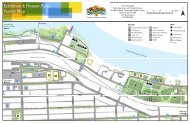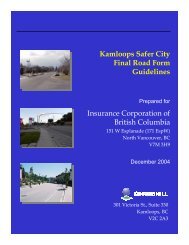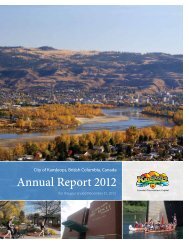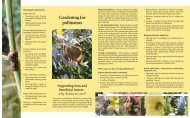Kamloops Heritage Register - City of Kamloops
Kamloops Heritage Register - City of Kamloops
Kamloops Heritage Register - City of Kamloops
You also want an ePaper? Increase the reach of your titles
YUMPU automatically turns print PDFs into web optimized ePapers that Google loves.
CITY OF KAMLOOPS HERITAGE REGISTER 2007-2008<br />
PIONEER CEMETERY, 780 LORNE STREET<br />
Description <strong>of</strong> Historic Place<br />
Set on a flat terrain overlooking the Thompson River and surrounded by a screen <strong>of</strong> mature<br />
deciduous and coniferous trees, the historic Pioneer Cemetery is the oldest burial ground in<br />
<strong>Kamloops</strong>. It is located north <strong>of</strong> Lorne Street at the northeast end <strong>of</strong> town and was closed in<br />
approximately 1900. The cemetery now functions as a park and a number <strong>of</strong> original tombstones<br />
have been relocated to the southwest corner <strong>of</strong> the site.<br />
<strong>Heritage</strong> Value<br />
The Pioneer Cemetery is valued as the oldest burial ground in <strong>Kamloops</strong>, adapted over time to<br />
shifts in the population and community focus in <strong>Kamloops</strong>. It was initially established in 1876 on<br />
private land owned by rancher John Peterson (1825-1908). The cemetery was located near his<br />
home and provided a privately owned space for burial <strong>of</strong> early <strong>Kamloops</strong> residents. During the<br />
construction <strong>of</strong> the Canadian Pacific Railway in the area from 1883 to 1885, and the subsequent<br />
population and economic boom, the <strong>Kamloops</strong> town site extended east, and Peterson’s land -<br />
including the title to the cemetery - was purchased by the New Town Syndicate in 1884. This<br />
syndicate was owned by managing partners Charles Edward Pooley (1845-1912), a Victoria<br />
resident and member <strong>of</strong> the legislature, William Ward (1865-1913), the manager <strong>of</strong> the Bank <strong>of</strong><br />
B.C. and partner in the Douglas Lake Ranch, and John Andrew Mara (1840-1920), a merchant<br />
and former MLA and MP. The syndicate owned a large portion <strong>of</strong> the original and new town site<br />
in <strong>Kamloops</strong>. They charged a small fee for burial in what was, at the time, the only local<br />
cemetery. The <strong>City</strong> <strong>of</strong> <strong>Kamloops</strong> was incorporated in 1893, and five years later purchased land<br />
for the first public cemetery, which became the Pleasant Street Cemetery. The Pioneer Cemetery<br />
was used until approximately 1900. Over time, it fell into disrepair and tombstones were<br />
vandalized. In 1962, the provincial government decreed that the <strong>City</strong> look after the site, which<br />
was then converted into a park; the remaining tombstones were relocated to the southwest corner<br />
<strong>of</strong> the site, laid horizontally in concrete and surrounded by remains <strong>of</strong> an historic wrought iron<br />
fence.<br />
A physical testament to the strength and early beginnings <strong>of</strong> the <strong>Kamloops</strong> community, the<br />
cemetery embodies a collective memory and spirit. A wide variety <strong>of</strong> pioneers were interred at<br />
the cemetery, including many community members who reflect the history, development,<br />
heroism and tragedies <strong>of</strong> the early history <strong>of</strong> <strong>Kamloops</strong>. The earliest headstone is that <strong>of</strong> John<br />
Tannantt Ussher (1844-1879) noted as “Killed by the McLean Bros.” Other pioneers buried here<br />
include John Peterson and his wife, Margaret Alexandra (died 1898) Daniel Berkley Wiley<br />
(1832-1889), Peter J. Fraser (1869-1895), Reverend Freeman Harding (1842-1893) and members<br />
<strong>of</strong> the Edwards, Latremouille and Hancock families.<br />
The cemetery also features many decorative and unique monuments and headstones, in materials<br />
such as sandstone, granite and marble that capture the fundamental nature <strong>of</strong> its original design<br />
as a rustic Victorian park cemetery. The tombstones were generally vertical, monumental in style<br />
and inscribed with traditional Victorian symbols <strong>of</strong> death such as the scroll, column, tree trunk,<br />
clasped hands and star.<br />
Donald Luxton & Associates Inc.: 2008<br />
- 32 -

















